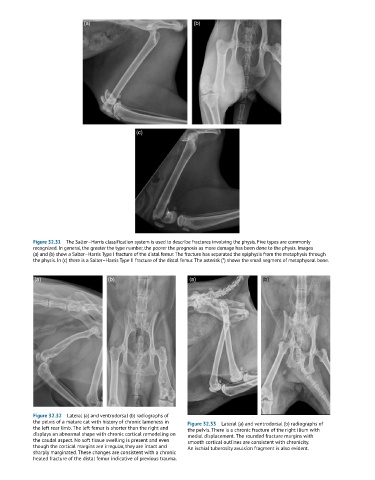Page 586 - Feline diagnostic imaging
P. 586
Figure 32.31 The Salter–Harris classification system is used to describe fractures involving the physis. Five types are commonly
recognized. In general, the greater the type number, the poorer the prognosis as more damage has been done to the physis. Images
(a) and (b) show a Salter–Harris Type I fracture of the distal femur. The fracture has separated the epiphysis from the metaphysis through
the physis. In (c) there is a Salter–Harris Type II fracture of the distal femur. The asterisk (*) shows the small segment of metaphyseal bone.
Figure 32.32 Lateral (a) and ventrodorsal (b) radiographs of
the pelvis of a mature cat with history of chronic lameness in Figure 32.33 Lateral (a) and ventrodorsal (b) radiographs of
the left rear limb. The left femur is shorter than the right and the pelvis. There is a chronic fracture of the right ilium with
displays an abnormal shape with chronic cortical remodeling on medial displacement. The rounded fracture margins with
the caudal aspect. No soft tissue swelling is present and even smooth cortical outlines are consistent with chronicity.
though the cortical margins are irregular, they are intact and An ischial tuberosity avulsion fragment is also evident.
sharply marginated. These changes are consistent with a chronic
healed fracture of the distal femur indicative of previous trauma.

